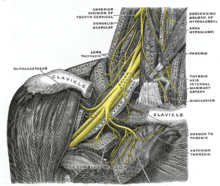Parsonage–Turner syndrome, also known as acute brachial neuropathy, neuralgic amyotrophy and abbreviated PTS, is a syndrome of unknown cause; although many specific risk factors have been identified (such as; post-operative, post-infectious, post-traumatic or post-vaccination).[4] It is also known as brachial plexitis, and results in brachial plexus inflammation without any apparent shoulder injury. PTS can manifest with severe pain in the shoulder or arm, followed by numbness and weakness.[5]
| Parsonage–Turner syndrome | |
|---|---|
| Other names | acute brachial radiculitis,[1] Parsonage–Aldren–Turner syndrome', neuralgic amyotrophy,[2] brachial neuritis, brachial plexus neuropathy,[3] brachial plexitis, acute brachial neuropathy |
 | |
| The right brachial plexus with its short branches, viewed from in front. | |
| Specialty | Neurology |
| Named after |
|
Parsonage–Turner syndrome occurs in about 1.6 out of 100,000 people every year.[6]
Signs and symptoms
editThis syndrome can begin with severe shoulder or arm pain followed by weakness and numbness.[5] Those with Parsonage–Turner experience acute, sudden-onset pain radiating from the shoulder to the upper arm. Affected muscles become weak and atrophied, and in advanced cases, paralyzed. Occasionally, there will be no pain and just paralysis, and sometimes just pain, not ending in paralysis.[citation needed] MRI may assist in diagnosis.[7] Scapular winging is commonly seen.
Mechanism
editParsonage-Turner involves neuropathy of the suprascapular nerve in 97% of cases, and variably involves the axillary and subscapular nerves. As such, the muscles usually involved are the supraspinatus and infraspinatus, which are both innervated by the suprascapular nerve. Involvement of the deltoid is more variable, as it is innervated by the axillary nerve.[8]
Diagnosis
editDiagnosis often takes three to nine months to be made, as the condition is often unrecognised by physicians.[9]
Differential diagnosis
editThe differential focuses on distinguishing it from similar entities such as quadrilateral space syndrome, which involves the teres minor and variably the deltoid, and suprascapular nerve impingement at the spinoglenoid notch, which predominantly involves the infraspinatus.[8]
Prognosis
editDespite its wasting and at times long-lasting effects, most cases are resolved by the body's healing system, and recovery is usually good in 18–24 months, depending on how old the person in question is. For instance, a six-year-old could have brachial neuritis for only around six months, but a person in their early 50s could have it for more than three years.[citation needed]
It was traditionally thought that most people would regain around 70 to 90 percent of their original strength and function levels,[10] however most recent studies suggest that long-term complications are more common than previously thought.[11]
Eponym
editIt is named after British neurologists Maurice Parsonage and John Turner,[12][13] who described 136 cases in a 1948 Lancet publication.[14][4] Other cases with similar symptom presentation had previously been published as early as 1897, but these publications were not as extensive as Parsonage and Turner's 1948 publication.[4]
See also
editReferences
edit- ^ Wheeless, Clifford R. (30 August 2009). "Parsonage-Turner Syndrome". Wheeless' Textbook of Orthopedics @ wheelessonline.com. Retrieved 11 October 2009.
- ^ Cary D. Alberstone; Michael Steinmetz; Edward C. Benzel (28 January 2009). Anatomic Basis of Neurologic Diagnosis. Thieme. pp. 105–. ISBN 978-0-86577-976-1. Retrieved 4 November 2010.
- ^ Charles A. Rockwood (14 January 2009). The Shoulder. Elsevier Health Sciences. pp. 1376–. ISBN 978-1-4160-3427-8. Retrieved 4 November 2010.
- ^ a b c Feinberg JH, Radecki J (2010). "Parsonage-turner syndrome". HSS J. 6 (2): 199–205. doi:10.1007/s11420-010-9176-x. PMC 2926354. PMID 21886536.
- ^ a b "NINDS Brachial Plexus Injuries: Information Page". National Institute of Neurological Disorders and Stroke. September 29, 2008. Archived from the original on 2 December 2016. Retrieved 11 October 2009.
- ^ Beghi E, Kurland LT, Mulder DW, Nicolosi A (1985). "Brachial plexus neuropathy in the population of Rochester, Minnesota, 1970-1981". Ann. Neurol. 18 (3): 320–3. doi:10.1002/ana.410180308. PMID 2996415. S2CID 23882478.
- ^ William E. Brant; Clyde A. Helms (2007). Fundamentals of diagnostic radiology. Lippincott Williams & Wilkins. pp. 1–. ISBN 978-0-7817-6135-2. Retrieved 4 November 2010.
- ^ a b Frank Gaillard MD. "Parsonage-Turner syndrome". Radiopaedia.
- ^ van Alfen, Nens; van Engelen, Baziel GM; Hughes, Richard AC (23 January 2008). Van Alfen, Nens (ed.). "Treatment for idiopathic and hereditary neuralgic amyotrophy (brachial neuritis)". Cochrane Database of Systematic Reviews. Chichester, UK: John Wiley & Sons, Ltd. doi:10.1002/14651858.cd006976.
- ^ "Parsonage Turner Syndrome". National Organization for Rare Disorders.
- ^ "Parsonage Turner syndrome". Genetic and Rare Diseases Information Center. National Center for Advancing Translational Sciences. Archived from the original on 2021-06-08. Retrieved 2021-04-21.
- ^ synd/1910 at Who Named It?
- ^ Parsonage MJ, Turner JW (June 1948). "Neuralgic amyotrophy; the shoulder-girdle syndrome". Lancet. 1 (6513): 973–8. doi:10.1016/S0140-6736(48)90611-4. PMID 18866299.
- ^ Sanders, Lisa (19 November 2020). "He Finished His First Marathon. Then His Arm Felt Weak". The New York Times. Retrieved 21 November 2020.